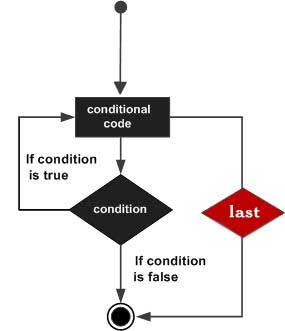
- Perl - Home
- Perl - Introduction
- Perl - Environment
- Perl - Syntax Overview
- Perl - Data Types
- Perl - Variables
- Perl - Scalars
- Perl - Arrays
- Perl - Hashes
- Perl - IF...ELSE
- Perl - Loops
- Perl - Operators
- Perl - Date & Time
- Perl - Subroutines
- Perl - References
- Perl - Formats
- Perl - File I/O
- Perl - Directories
- Perl - Error Handling
- Perl - Special Variables
- Perl - Coding Standard
- Perl - Regular Expressions
- Perl - Sending Email
- Perl - Socket Programming
- Perl - Object Oriented
- Perl - Database Access
- Perl - CGI Programming
- Perl - Packages & Modules
- Perl - Process Management
- Perl - Embedded Documentation
- Perl - Functions References
- Perl Useful Resources
- Perl - Questions and Answers
- Perl - Quick Guide
- Perl - Cheatsheet
- Perl - Useful Resources
- Perl - Discussion
Perl last Statement
When a last statement is encountered inside a loop, the loop is immediately terminated and the program control resumes at the next statement following the loop. You can provide a LABEL with last statement where LABEL is the label for a loop. A last statement can be used inside a nested loop where it will be applicable to the nearest loop if a LABEL is not specified.
If there is any continue block on the loop, then it is not executed. You will see the continue statement in a separate chapter.
Syntax
The syntax of a last statement in Perl is −
last [LABEL];
Flow Diagram

Example 1
#!/usr/local/bin/perl $a = 10; while( $a < 20 ) { if( $a == 15) { # terminate the loop. $a = $a + 1; last; } print "value of a: $a\n"; $a = $a + 1; } When the above code is executed, it produces the following result −
value of a: 10 value of a: 11 value of a: 12 value of a: 13 value of a: 14
Example 2
Let's take one example where we are going to use a LABEL along with next statement −
#!/usr/local/bin/perl $a = 0; OUTER: while( $a < 4 ) { $b = 0; print "value of a: $a\n"; INNER:while ( $b < 4) { if( $a == 2) { # terminate outer loop last OUTER; } $b = $b + 1; print "Value of b : $b\n"; } print "\n"; $a = $a + 1; } When the above code is executed, it produces the following result −
value of a : 0 Value of b : 1 Value of b : 2 Value of b : 3 Value of b : 4 value of a : 1 Value of b : 1 Value of b : 2 Value of b : 3 Value of b : 4 value of a : 2